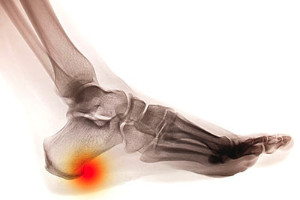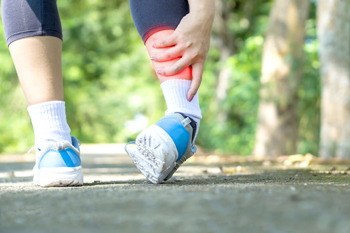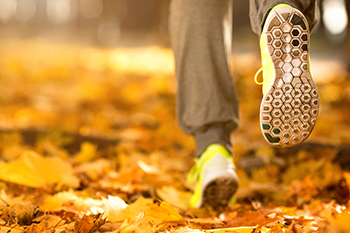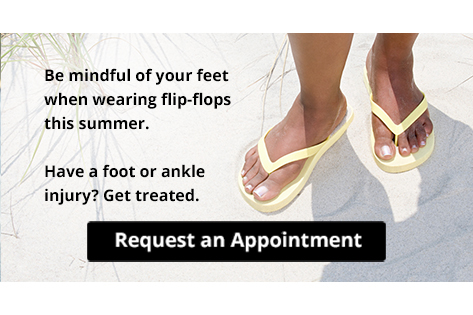Connect With Us
Blog
Items filtered by date: August 2022
Causes and Treatment of Heel Spurs

A heel spur is caused when calcium builds up on the heel bone. It can be a plantar heel spur, which grows on the bottom of the heel, or a posterior heel spur, which grows on the back of the heel. A great many people have heel spurs and won’t know it until the spurs show up on an X-ray. Others with heel spurs can experience a great deal of pain, which can be acute, intermittent, or chronic. The precise cause of heel spurs has been debated by scientists, but what is clear is that more than 80 percent of people who have them are overweight. Older people also are more likely to develop heel spurs, as are post-menopausal women. Possible causes include arthritis, plantar fasciitis, excessive running or jogging, and shoes without adequate cushioning in the heel. The two main ways to treat bone spurs are resting and icing the foot and wearing orthotic shoe inserts. If the pain caused by heel spurs continues or worsens, it is a good idea to visit a podiatrist who may suggest further treatment options, such as corticosteroid injections and being fitted for custom orthotics.
Heel spurs can be incredibly painful and sometimes may make you unable to participate in physical activities. To get medical care for your heel spurs, contact one of our podiatrists from Bergen Foot & Ankle. Our doctors will do everything possible to treat your condition.
Heels Spurs
Heel spurs are formed by calcium deposits on the back of the foot where the heel is. This can also be caused by small fragments of bone breaking off one section of the foot, attaching onto the back of the foot. Heel spurs can also be bone growth on the back of the foot and may grow in the direction of the arch of the foot.
Older individuals usually suffer from heel spurs and pain sometimes intensifies with age. One of the main condition's spurs are related to is plantar fasciitis.
Pain
The pain associated with spurs is often because of weight placed on the feet. When someone is walking, their entire weight is concentrated on the feet. Bone spurs then have the tendency to affect other bones and tissues around the foot. As the pain continues, the feet will become tender and sensitive over time.
Treatments
There are many ways to treat heel spurs. If one is suffering from heel spurs in conjunction with pain, there are several methods for healing. Medication, surgery, and herbal care are some options.
If you have any questions feel free to contact our offices located in Fort Lee, NJ and Flushing, NY . We offer the latest in diagnostic and treatment technology to meet your needs.
Ankle Pain Caused by Running

Every time a runner takes a step, force is transmitted through the foot and ankle up into the legs, with the ankle taking the brunt. Since the average runner takes between 160 to 180 steps a minute, it is easy to see why ankle pain is common. It is believed that ankle pain results from a combination of factors, including muscle imbalance, overuse, previous injuries, bone problems, and running shoes. Any weakness or tightness in the muscles of the foot, ankle, calf, knee, and hip can affect how the foot reacts when it hits the ground ultimately affecting the ankle joint. Increasing the length or intensity of a run too quickly can impact the strength and stability of the ankle. Runners who go back to their routine too soon after an injury jeopardize the health of their ankles and may result in re-injury. Bone injuries, such as stress fractures, can cause tightness and stiffness that become painful. Running on old or worn shoes can cause pain also. They can lose their cushioning, shock absorption, and shape, which can place more pressure on the ankle. Experts recommend that running shoes be replaced every 500 miles. For help with ankle pain, it is suggested that you consult a podiatrist who can examine your ankles and discuss any treatment that may be needed.
Ankle pain can be caused by a number of problems and may be potentially serious. If you have ankle pain, consult with one of our podiatrists from Bergen Foot & Ankle. Our doctors will assess your condition and provide you with quality foot and ankle treatment.
Ankle pain is any condition that causes pain in the ankle. Due to the fact that the ankle consists of tendons, muscles, bones, and ligaments, ankle pain can come from a number of different conditions.
Causes
The most common causes of ankle pain include:
- Types of arthritis (rheumatoid, osteoarthritis, and gout)
- Ankle sprains
- Broken ankles
- Achilles tendinitis
- Achilles tendon rupture
- Stress fractures
- Bursitis
- Tarsal tunnel syndrome
- Plantar fasciitis
Symptoms
Symptoms of ankle injury vary based upon the condition. Pain may include general pain and discomfort, swelling, aching, redness, bruising, burning or stabbing sensations, and/or loss of sensation.
Diagnosis
Due to the wide variety of potential causes of ankle pain, podiatrists will utilize a number of different methods to properly diagnose ankle pain. This can include asking for personal and family medical histories and of any recent injuries. Further diagnosis may include sensation tests, a physical examination, and potentially x-rays or other imaging tests.
Treatment
Just as the range of causes varies widely, so do treatments. Some more common treatments are rest, ice packs, keeping pressure off the foot, orthotics and braces, medication for inflammation and pain, and surgery.
If you have any questions, please feel free to contact our offices located in Fort Lee, NJ and Flushing, NY . We offer the newest diagnostic and treatment technologies for all your foot care needs.
Foot Care Concerns for Trail Runners

Most runners have some form of foot pain at some point. Complaints range from blisters to plantar fasciitis, and even stress fractures. Taking care of the feet is sometimes overlooked by runners who concentrate more on other body parts. For trail runners who traverse uneven, wet, or slippery terrain, attention to foot health can be paramount. First and foremost for any runner is proper footwear. Be sure to find shoes that are made specifically for natural terrain and fit well. Socks can be just as important as shoes. Look for socks that wick moisture and prevent blisters. Try to keep your feet dry, if at all possible. Some runners tend the calluses on the sole of the feet with a pumice, but it’s a good idea to see a podiatrist if they cause pain or gait problems. Orthotics may be a solution to avoiding them. Other ways that trail runners can care for their feet are to keep toenails carefully trimmed, give your feet a massage, and pamper them after a run. If you experience foot pain or problems caused by running, please visit a podiatrist for more information.
Exercising your feet regularly with the proper foot wear is a great way to prevent injuries. If you have any concerns about your feet, contact one of our podiatrists of Bergen Foot & Ankle. Our doctors will treat your foot and ankle needs.
How to Prevent Running Injuries
Many common running injuries are caused by overuse and overtraining. When the back of the kneecap starts wearing out and starts causing pain in your knee, this is commonly referred to as runner’s knee. Runner’s knee is a decrease in strength in your quadriceps and can occur if you’re not wearing properly fitted or supporting shoes. To prevent runner’s knee, focusing on hip strengthening is a good idea, as well as strengthening your quads to keep the kneecaps aligned.
What Are Some Causes of Running Injuries?
- One cause of a common running injury is called iliotibial band syndrome.
- Plantar fasciitis is also another common injury.
- Stress fractures can occur from overtraining, lack of calcium, or even your running style.
Best Ways to Prevent Running Injuries
- Wear footwear that fits properly and suits your running needs.
- Running shoes are the only protective gear that runners have to safeguard them from injury.
- Make a training schedule. Adding strengthening exercises as well as regular stretching can help keep you strong and limber and can lessen the possibility of injuries.
- Stretching keeps muscles limber; this will help you gain better flexibility.
If you have any questions please feel free to contact our offices located in Fort Lee, NJ and Flushing, NY . We offer the newest diagnostic and treatment technologies for all your foot and ankle needs.

